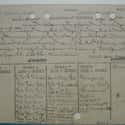-

(#10) There Were Over 400 Other Asymptomatic Typhoid Carriers
Mallon's discovery in 1906 as the first asymptomatic carrier in the country made waves in the scientific community. By the time of Mallon's death in 1938, over 400 other "healthy" carriers had been identified. According to records, it appears not one of them received forced confinement like Typhoid Mary.
This raised questions about epidemic and public health protocol. Many questioned whether it was justifiable to confine someone against their will for the greater good of society. The medical community contested that Mallon's refusal to cooperate or act honestly regarding her diagnosis warranted her rough treatment and confinement.
-
(#9) She Was America's First Identified Asymptomatic Typhoid Carrier
Mallon was the first identified asymptomatic carrier of typhoid, meaning she carried the disease without displaying any of the symptoms. This was a breakthrough discovery at the time, but unfortunately, no protocol existed to address such a problem. Health authorities did have the right to quarantine people who posed a risk to society health-wise; however, even though authorities knew Mallon was somehow the missing link in the typhoid outbreaks, they couldn't exactly prove how or why.
Mallon's anger and claims of a government conspiracy only worsened the already fraught situation. At certain times, the public even sided with Mallon; however, she was undoubtedly the carrier, as her compiled work history left a path of repeated sickness and death in its wake.
Only in 2013 did Stanford researchers made a breakthrough in which they discovered how Mallon was able to carry the bacteria yet not display symptoms. Simply explained, the salmonella bacteria behind typhoid can hide in immune cells known as macrophages and essentially hijack their metabolism in their favor. If the germs are successful in "hacking" the macrophages, then the person (in this case, Mary Mallon), can spread the germ unknowingly while remaining healthy themselves.
-
(#7) She Didn't Wash Her Hands While Cooking
Health officials didn't expect to encounter typhoid in wealthy, upper-middle-class families in New York, as it was typically associated with poverty and poor hygiene.
Upon her first questionings from New York City Health officials in 1907, Mallon admitted she didn't see the point in washing her hands. Germ theory was still fairly new, and she didn't seem to believe sickness could be transferred through physical contact or lack of proper washing.
-
(#5) Mallon Broke Her Promise And Worked As A Hospital Cook, Infecting 25 People
Mallon was released from her first quarantine under the condition that she wouldn't continue working as a cook. In 1910, she was released and began a job as a laundress. Mallon promptly disappeared from her washing position, however, and immediately began to serve families again.
For five years, she managed to evade the authorities by constantly changing her name and regularly changing jobs. In 1915, an outbreak of 25 new typhoid cases occurred at Sloan Maternity Hospital in New York. Mallon was found working as a cook there, and she was promptly arrested and returned to quarantine.
-
(#8) A Sanitary Engineer Identified Her As The Carrier In 1906
In 1906, George Soper, a sanitary engineer for the New York Department of Health, was hired by a homeowner whose family had suffered a violent and inexplicable typhoid outbreak.
His first instinct was to look to the servants and cooks. Specifically, he was curious about an Irish immigrant who had been hired as a cook for the family three weeks before the outbreak (the exact incubation period of the salmonella bacteria that causes typhoid). He conducted a background check on her work history and saw the trail of typhoid victims. Coupled with the culprits' rapid job and name changes, Soper knew he had found his carrier.
Soper interviewed Mallon and eventually suggested she could be the carrier causing the outbreaks. Mallon staunchly denied his accusations. Authorities became involved before Mallon could be restrained and formally tested for the bacteria.
-
(#11) Typhoid Clotted Victims' Blood And Distended Their Stomachs
In the early 1900s, typhoid was still a fairly dangerous disease; the mortality rate was around 10%. A doctor introduced the first vaccine in 1896, which helped considerably for soldiers (who were more likely to die from typhoid than combat), but it hadn't quite become widespread enough to be entirely effective for the masses.
Typhoid sufferers start exhibiting symptoms between one and three weeks after infection, usually starting with a dangerously high fever along with nausea, vomiting, headaches, and muscle pain. Next, a distinctive rash appears on the chest. Without treatment, intestinal bleeding can occur, leading to blood clots under the skin. In the most dangerous cases, the abdomen will distend.
New Random Displays Display All By Ranking
About This Tool
Our data comes from Ranker, If you want to participate in the ranking of items displayed on this page, please click here.














